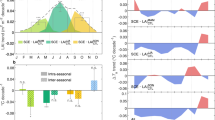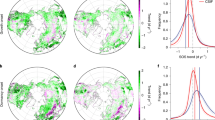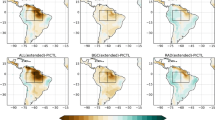Abstract
Much research focuses on how the terrestrial biosphere influences climate through changes in surface albedo (reflectivity), stomatal conductance and leaf area index (LAI). By using a fully-coupled GCM (HadCM3LC), our research objective was to induce an increase in the growth of global vegetation to isolate the effect of increased LAI on atmospheric exchange of heat and moisture. Our Control simulation had a mean global net primary production (NPP) of 56.3 GtCyr−1 which is half that of our scenario value of 115.1 GtCyr−1. LAI and latent energy (Q E) were simulated to increase globally, except in areas around Antarctica. A highly productive biosphere promotes mid-latitude mean surface cooling of ~2.5°C in the summer, and surface warming of ~1.0°C in the winter. The former response is primarily the result of reduced Bowen ratio (i.e. increased production of Q E) in combination with small increases in planetary albedo. Response in winter temperature is likely due to decreased planetary albedo that in turn permits a greater amount of solar radiation to reach the Earth’s surface. Energy balance calculations show that between 75° and 90°N latitude, an additional 2.4 Wm−2 of surface heat must be advected into the region to maintain energy balance, and ultimately causes high northern latitudes to warm by up to 3°C. We postulate that large increases in Q E promoted by increased growth of terrestrial vegetation could contribute to greater surface-to-atmosphere exchange and convection. Our high growth simulation shows that convective rainfall substantially increases across three latitudinal bands relative to Control; in the tropics, across the monsoonal belt, and in mid-latitude temperate regions. Our theoretical research has implications for applied climatology; in the modeling of past “hot-house” climates, in explaining the greening of northern latitudes in modern-day times, and for predicting future changes in surface temperature with continued increases in atmospheric CO2.










Similar content being viewed by others
References
Barry L, Craig GC, Thuburn J (2002) Poleward heat transport by the atmospheric heat engine. Nature 415:774–777
Bender M (2003) Climate-biosphere interactions on glacial–interglacial timescales. Global Biogeochem Cycles 17. doi:10.1029/2002GB001932
Beringer J, McIlwaine J, Lynch AH, Chapin FS, Bonan GB (2002) The use of a reduced form model to assess the sensitivity of a land surface model to biotic surface parameters. Clim Dyn 19:455–466. doi:10.1007/s00382-002-0237-9
Betts AK (2007) Coupling of water vapor convergence, clouds, precipitation, and land-surface processes. J Geophys Res 112. article number D10108
Betts RA (2004) Global vegetation and climate: self-beneficial effects, climate forcings and climate feedbacks. J Phys IV 121:37–60. doi:10.1051/jp4:2004121002
Bunn AG, Goetz SJ (2006) Trends in satellite-observed circumpolar photosynthetic activity from 1982 to 2003: the influence of seasonality, cover type and vegetation density. Earth Interact. 10: article no 12–2006
Cox PM (2001) Description of the TRIFFID dynamics global vegetation model. Technical Note 24, Hadley Centre, UK Met Office
Cox PM, Betts RA, Bunton CB, Essery RLH, Rowntree PR, Smith J (1998) The impact of new land surface physics on the GCM simulation of climate and climate sensitivity. Clim Dyn 15:183–203. doi:10.1007/s003820050276
Delbart N, Le Toan T, Kergoat L, Fedotova V (2006) Remote sensing of spring phenology in boreal regions: a free of snow-effect method using NOAA-AVHRR and SPOT-VGT data (1982–2004). Remote Sens Environ 101:52–62. doi:10.1016/j.rse.2005.11.012
Dye DG, Tucker CJ (2003) Seasonality and trends of snow-cover, vegetation index, and temperature in northern Eurasia. Geophys Res Lett 30:1405. doi:10.1029/2002GL016384
Essery RLH, Best JJ, Betts RA, Cox PM, Taylor CM (2003) Explicit representation of subgrid heterogeneity in a GCM land surface scheme. J Hydrometeorol 4:530–543. doi:10.1175/1525-7541(2003)004<0530:EROSHI>2.0.CO;2
Gallimore RG, Kutzbach JE (1996) Role of orbitally induced changes in tundra area in the onset of glaciation. Nature 381:503–505. doi:10.1038/381503a0
Gordon C, Cooper C, Senior CA, Banks H, Gregory JM, Johns TC, Mitchell JFB, Wood RA (2000) The simulation of SST, sea ice extents and ocean heat transports in a version of the Hadley Centre coupled model without flux adjustments. Clim Dyn 16:147–168. doi:10.1007/s003820050010
Irannejad P, Henderson-Sellers A, Sharmeen S (2003) Importance of land-surface parameterization for latent heat simulation in global atmospheric models. Geophys Res Lett 30. doi:10.1029/2003GL018044
Kleidon A, Fraedrich K, Kirk E, Lunkeit F (2006) Maximum entropy production and the strength of boundary layer exchange in an atmospheric general circulation model. Geophys Res Lett 33:L06706. doi:10.1029/2005GL025373
Kleidon A, Fraedrich K, Heimann M (2000) A green planet versus a desert world: estimating the maximum effect of vegetation on the land surface climate. Clim Change 44:471–493. doi:10.1023/A:1005559518889
MacKinnon DJ, Clow GD, Tigges RK, Reynolds RL, Chavez PS (2004) Comparison of aerodynamically and model-derived roughness lengths (zo) over diverse surfaces, central Mojave Desert, California, USA. Geomorphology 63:103–113. doi:10.1016/j.geomorph.2004.03.009
Monson RK (2003) Gene duplication, neofunctionalization, and the evolution of C4 photosynthesis. Int J Plant Sci 164:S43–S54. doi:10.1086/368400
Notaro M, Vavrus S, Liu ZY (2007) Global vegetation and climate change due to future increases in CO2 as projected by a fully coupled model with dynamic vegetation. J Clim 20:70–90. doi:10.1175/JCLI3989.1
Otto-Bliesner BL, Upchurch GR Jr (1997) Vegetation-induced warming of high-latitude regions during the late-Cretaceous period. Nature 385:804–807. doi:10.1038/385804a0
Palmer JR, Totterdell IJ (2001) Production and export in a global ocean ecosystem model. Deep Sea Res 48:1169–1198. doi:10.1016/S0967-0637(00)00080-7
Pauluis O, Held IM (2002) Entropy budget of an atmosphere in radiative-convective equilibrium. Part II: latent heat transport and moist processes. J Atmos Sci 59:140–149. doi:10.1175/1520-0469(2002)059<0140:EBOAAI>2.0.CO;2
Peisker M, Henderson SA (1992) Carbon: terrestrial C4 plants. Plant Cell Environ 15:987–1004. doi:10.1111/j.1365-3040.1992.tb01651.x
Piao SL, Friedlingstein P, Ciais P, Zhou LM, Chen AP (2006) Effect of climate and CO2 changes on the greening of the northern hemisphere over the past two decades. Geophys Res Lett 33:L23402. doi:10.1029/2006GL028205
Rooney GG, Claxton BM (2006) Comparison of the Met Office’s Surface Exchange Scheme, MOSES, against field observations. Q J R Meteorol Soc 132:425–446. doi:10.1256/qj.04.95
Russell GL, Rind D (1999) Response to CO2 transient increase in the GISS coupled model: regional coolings in a warming climate. J Clim 12:531–539. doi:10.1175/1520-0442(1999)012<0531:RTCTII>2.0.CO;2
Sage RF (2004) The evolution of C4 photosynthesis. New Phytol 161:341–370. doi:10.1111/j.1469-8137.2004.00974.x
Schmidt GA, Mysak LA (1996) Can increased poleward oceanic heat flux explain the warm Cretaceous climate? Paleoceanography 11:579–593. doi:10.1029/96PA01851
Sewall JO, Sloan LC, Huber M, Wing SL (2000) Climate sensitivity to changes in land surface characteristics. Global Planet Change 26:445–465. doi:10.1016/S0921-8181(00)00056-4
Shutova E, Wielgolaski FE, Karlsen SR, Makarova O, Berlina N, Filimonova T, Haraldsson E, Aspholm PE, Flo L, Hogda KA (2006) Growing seasons of Nordic mountain birch in northernmost Europe as indicated by long-term field studies and analyses of satellite images. Int J Biometeorol 51:155–166. doi:10.1007/s00484-006-0042-y
Sitch S, McGuire AD, Kimbass J, Gedney N, Gamon J, Engstrom R, Wolf A, Zhuang Q, Clein J, McDonald KC (2007) Assessing the carbon balance of circumpolar Arctic tundra using remote sensing and process modeling. Ecol Appl 17:213–234. doi:10.1890/1051-0761(2007)017[0213:ATCBOC]2.0.CO;2
Trenberth KE, Caron JM (2001) Estimates of meridional atmosphere and ocean heat transports. J Clim 14:3433–3443. doi:10.1175/1520-0442(2001)014<3433:EOMAAO>2.0.CO;2
von Caemmerer S, Furbank RT (2003) The C4 pathway: an efficient CO2 pump. Photosynth Res 77:191–207. doi:10.1023/A:1025830019591
Xue Y, Juang HMH, Li WP, Prince S, DeFries R, Jiao Y, Vasic R (2004) Role of land-surface processes in monsoon development: east Asia and west Africa. J Geophys Res 109. doi:10.1029/2003JD003556
Zhang J, Walsh JE (2006) Thermodynamic and hydrological impacts of increasing greenness in northern latitudes. J Hydrometeorol 7:1147–1163. doi:10.1175/JHM535.1
Zhou L, Kaufmann RK, Tian Y, Myneni RB, Tucker CJ (2003) Relation between inter-annual variations in satellite measures of northern forest greenness and climate between 1982 and 1999. J Geophys Res Atmos 108:4004. doi:10.1029/2002JD002510
Author information
Authors and Affiliations
Corresponding author
Appendices
Appendices
1.1 Appendix 1
Table 3
1.2 Appendix 2
Table 4
Rights and permissions
About this article
Cite this article
Cowling, S.A., Jones, C.D. & Cox, P.M. Greening the terrestrial biosphere: simulated feedbacks on atmospheric heat and energy circulation. Clim Dyn 32, 287–299 (2009). https://doi.org/10.1007/s00382-008-0481-8
Received:
Accepted:
Published:
Issue Date:
DOI: https://doi.org/10.1007/s00382-008-0481-8




